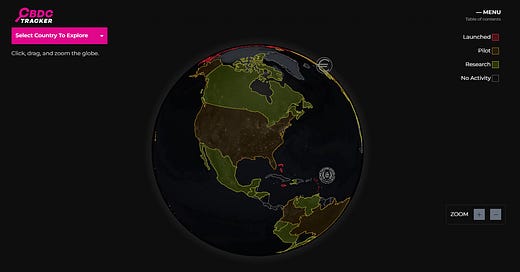Tracking CBDCs
Central bank digital currencies (CBDCs) are advancing worldwide, but not every country is moving in the same direction.
Central bank digital currencies (CBDCs) are advancing worldwide, but not every country is moving in the same direction. While some governments are speeding ahead, others are backing away. Recent events in the United States, the Eurozone, and the United Kingdom show just how divided the global approach to CBDCs has become.
The Headline Data
According to the Human Rights Foundation’s CBDC Tracker, 10 countries have CBDCs that are open to the public; 40 countries, the Eurozone, the Eastern Caribbean Currency Union, and Hong Kong have CBDC pilots; and more than 72 countries are researching CBDCs. As it stands, more than 3.2 billion people currently live where CBDCs are available to the public.
Digging Deeper
The numbers only tell part of the story—what’s happening on the ground is even more telling.
Somewhat ironically, a London-based think tank launched a report titled “CBDCs: It’s Time for Action” the same day that Federal Reserve Chair Jerome Powell committed to never issue a CBDC so long as he is leading the central bank. The announcement puts the United States among a growing group of countries that have turned away from CBDCs. Australia, Canada, and Colombia have all made similar announcements over the past 12 months.
The European Central Bank, however, has taken the opposite approach. Reacting to one of President Donald Trump’s executive orders, European Central Bank board member Piero Cipollone said the Eurozone needs a CBDC because President Trump supports the “growth of lawful and legitimate dollar-backed stablecoins worldwide.” Before this, Cipollone recently argued that the Eurozone needs a CBDC because someone might have “forgotten their wallet or [doesn’t] have enough cash.”
If the United States is hitting the brakes and the Eurozone is speeding forward, the United Kingdom might be somewhere in the middle. In late 2024, the UK Treasury published a National Payments Vision. The document noted that no decision had been made to launch a CBDC. However, the Treasury stressed that “the UK cannot risk falling behind, hence we are continuing rapid and careful exploration of all relevant emerging technologies.”
As part of that exploration, the Bank of England revealed in early 2025 that it has been experimenting with offline payments, point-of-sale hardware, and API functionality for CBDCs. To take these experiments even further, the Bank of England also plans to launch a “Digital Pound Lab.” (These updates were the reason the United Kingdom recently advanced to the pilot stage in the Human Rights Foundation’s CBDC Tracker.)
Looking Forward
If nothing else, the cases in the United States, the Eurozone, and the United Kingdom show why tracking CBDC developments requires looking beyond the numbers. All three jurisdictions have reached the pilot stage, yet their approaches are drastically different. The United States sees no reason for issuing a CBDC, the Eurozone sees reasons everywhere, and the United Kingdom is still out searching for a reason. Or, picking up on the earlier analogy, the United States is hitting the brakes, the Eurozone is hitting the gas, and the United Kingdom is still deciding which way to turn.



